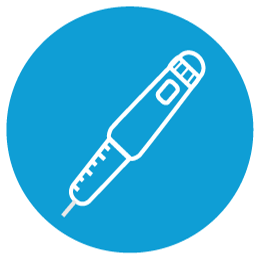These benefits on both Glycemic control & QoL are supported by growing evidence of Connectivity in the insulin management

Clinical Outcomes
Connected delivery devices have been associated with improved glycemic control1:
- Improved Time In Range
(increase in mean TIR of 1.9 hours per day, or TIR increased 8.5% of day)1 - Reduced HbA1c levels
(greater reduction in HbA1c from baseline (−0.98% vs −0.72%) when receiving alarms/reminders)2 - Reduced missed doses (by 43%)1


Quality of life
Connected delivery devices have good levels of patient satisfaction2 and are well perceived by patients with diabetes3:
- Easier to record their diabetes-related information
- Ability to keep all insulin and diabetes data in a single location
- Ability to be alerted when all insulin in the body had been metabolized3
References
- Adolfsson et al., 2020, Diabetes Technol Ther., 22(10):709-718
- Galindo et al., 2023, J Diabetes Sci Technol., 17(1):201-207
- Naïditch et al., 2023, Diabetes Ther 14, 303–318
Connected caps integrate data on insulin injections into diabetes management platforms

References
- Tejera-Perez C, et al. Diabetes Ther 2023;14:1077–91;
- Jamdade V, et al. Value Health 2022;25: S31
Increased TIR and fewer missed bolus injections after the introduction of a connected insulin
In two analyses, improvement in glycaemic outcomes and concordance with bolus injections were seen in people using connected insulin pens/caps
 |
Connected pen1 In people with T1D, a recent study has shown potential improvements in TIR and fewer missed bolus insulin injections after the introduction of a connected pen |
 |
Connected cap2 A recent pilot study assessed the effectiveness of a connected cap and found that device use was associated with a decrease in mean glucose and increased TIR in people with T1D Connected cap use was also associated with a reduction in the number of missed or mistimed insulin injections per month |
References
- Observational study investigating whether the connected NovoPen®6 could influence insulin regimen management and glycemic control in people with T1D on a basal-bolus insulin regimen with CGM in a real-world setting (N=94); Adolfsson P, et al. Diabetes Technol Ther 2020;22:709–18;
- Randomized, single-center, pilot study assessed the clinical impact of Insulclock® on glycemic control and variability, treatment concordance, and satisfaction in people with uncontrolled T1D (N=16); Gomez-Peralta F, et al. Diabetes Technol Ther 2020;22:686–90.
Real-world effectiveness of a connected system in adults with type 2 diabetes
Overview: evaluation of real-world effectiveness in people with type 2 diabetes using basal insulin* and a connected cap (Mallya) and app (Health2Sync)
Research design and population
- This retrospective cohort study evaluated 83 people with type 2 diabetes (≥20 years), registered on app and initiated connected cap use (index date) for a new/existing basal insulin* regimen
- In this study, 32 (38.6%) new basal insulin* users (i.e., who initiated basal insulin* during the identification period) and 51 (61.4%) previous basal insulin* users (i.e., who had an existing basal insulin* regimen prior to the identification period) were evaluated
Study methodology
- Eligible participants with type 2 diabetes were active on the app, used the connected cap and had more than one HbA1c value in the baseline (90 days pre-index) and follow-up periods (90–120 days post-index)
- Participants were identified from 05/01/2021 to 05/31/2022 (or 90 days prior to end of latest available data) and the study was conducted from 01/31/2021 to 08/31/2022 (or end of latest available data)
- Data were collated from the app and web platform
Outcomes
- Primary outcomes
- HbA1c change (baseline to follow-up) and
- HbA1c goal achievement
- Secondary outcomes included change in
- Fasting plasma glucose and
- Basal insulin* dose
- Safety outcomes included
- Hypoglycaemic event rate
(any hypoglycaemia and nocturnal hypoglycaemia)†
- Hypoglycaemic event rate
*The basal insulin used within this study was Gla-300. The connected cap and app used in this study were the Mallya cap and the Health2Sync app.
†Note: the study’s safety outcomes were not reported in the poster presented at ATTD 2023.
Wang CY et al. Poster 487 presented at ATTD 2023.
Mallya cap is an older version of SoloSmart that is connected to Sanofi SoloStar Pen
Significant HbA1c reduction after initiation of connected cap and diabetes management platform

Mean HbA1c decreased significantly from baseline to follow-up in both groups
*Indicates statistically significant difference (p<0.05). Hypoglycemia was experienced by 27.7% of people with T2D, 1.2% experienced a nocturnal hypoglycaemic event in the hours 00:00–05:59 and 15.7% experienced a hypoglycaemic event in the expanded nocturnal window 22:00–07:00. Please note, the study’s safety outcomes were not reported in the poster presented at ATTD 2023.
References
- Wang CY, et al. Presented at ATTD 2023. Poster #487.
Greater target achievement in new basal insulin users vs previous insulin users

HbA1c <7 % at baseline and follow-up

HbA1c reduction >0.5 %
HbA1c reduction >0.5% was achieved by 65.6% of new basal insulin users and 29.4% of previous basal insulin users
References
- Wang CY, et al. Poster presentation at ATTD 2023;#487;
Recent guidelines highlight how connected devices may support diabetes management for PWD on insulin therapy
ADA Standards of Care 20241
Connected insulin pens can be helpful for diabetes management and may be used in people with diabetes using injectable therapy
ADA/EASD Consensus Statements (2021 and 2022)2,3
The potential roles of connected devices for diabetes management have been noted in the recent ADA/EASD Consensus Statements:
- T1D: Technology (including connected insulin pens) can support more frequent communication between the PWD and their HCP
- T2D: For those needing insulin as part of their treatment, connected insulin pens and CSII are available
AACE Guidelines 20214
Connected pens may be recommended for all persons with diabetes who are treated with intensive insulin management, with 3 or more injections per day and who are not on insulin pump therapy, in whom an assessment of insulin dosing may help the person with diabetes and the clinician to further optimize the insulin regimen and avoid the stacking of rapid-acting insulin doses that could lead to hypoglycemia
AACE, American Association of Clinical Endocrinology; CSII, continuous subcutaneous insulin infusion; EASD, European Association for the Study of Diabetes.
References
- Volume 47 Issue Supplement_1 | Diabetes Care | American Diabetes Association (diabetesjournals.org).
- Holt RIG, et al. Diabetes Care 2021;44:2589–625;
- Davies MJ, et al. Diabetes Care 2022;45:2753–86;
- Grunberger G, et al. Endocr Pract 2021;27:505–37.
Impact of Connected Insulin Solutions

Personalized Support to improve Self-management skills of Patients
- Reminders of BG monitoring & insulin dose injection
- Encourage healthy habits - personalized, informative and educational leading to better behavior
- Easy access to HCP-based recommended doses: Optimum titration in shorter time
- Help reduce the day-to-day disease burden***

Complete and accurate patients’ data for evidence-based decisions
- Visualized dashboard help reading trends and patients’ compliance, not numbers
- Improve insulin self-management
- Practical and emotional support to patients between consultations
- Reduced Healthcare Professional Burden3

Accurate data on insulin
dosing & BG levels
- Ability to track Adherence
- Administering the right dose – too high lead to hypos & too low lead to hyper/Ka
- Minimize Causes of BG variation among patients & reduce cost of complications
* Research Partnership. HCP/Patient Qualitative/Quantitative Market Research. May 2018 (US, IT, GE)
SoloSmart is under SFDA registration review
**Insulin Connected Device Assessment – USA Mallya. MR Survey. Aug.2019
*** Automated BG & Dose recording via BT connected devices
The INNOVATE Study showed that patients adjusting their insulin dose with a home-based digital titration tool visited their Healthcare Professional less frequently compared with those receiving Enhanced Usual Therapy (EUT), thus reducing the demand on physician time and resources.
Connected insulin caps may further help to foster effective clinical conversations
Before use of connectivity
- Lengthy consultations
- Large amount of time spent identifying potential non-concordance to insulin
- Large amount of time spent providing solutions

Potential changes with connectivity
 |
Enhanced self-management |
 |
Improved drug concordance |
 |
Enhanced data management monitoring |
 |
Shared decision-making |
References
- Adolfsson P, et al. Diabetes Technol Ther 2020;22:709–18
- Ospelt E, et al. Clin Diabetes 2023;41:56–67.
SoloSmart is approved in Saudi Arabia under authorization number: MDMA-2-2024-0038
MAT-SA-2400096/v1/Apr 2024